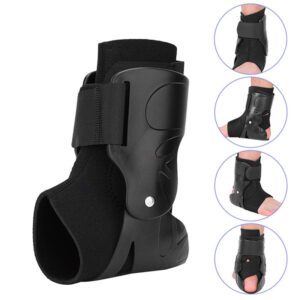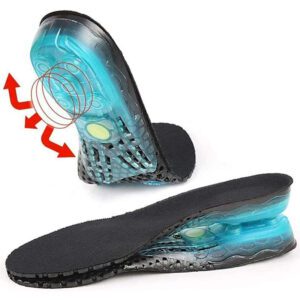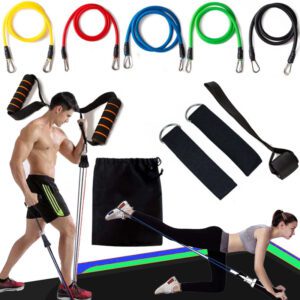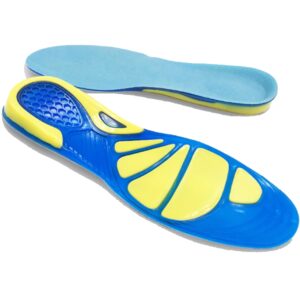If you’re like most people, you probably don’t give much thought to foam rollers until the time comes when you really need one. Maybe you’ve been experiencing some pain in your muscles and joints that regular massage or stretching just can’t seem to fix. Or maybe you’re an athlete who is always looking for ways to improve performance and reduce the risk of injury. In either case, a foam roller may be just what you need.
This article will give you a crash course on everything you need to know about foam rollers, including their history and invention, how to properly use them, and the many health benefits they offer. So make sure to read this article carefully before buying.
What Are Foam Rollers?
Foam rollers are cylindrical pieces of foam that are used for self-massage. They come in a variety of sizes, from small hand-held rollers to large ones that are meant to be used on the floor. You can also find foam rollers that come with a built-in massage ball, which is great for targeting specific muscle groups. Besides the long cylindrical foam rollers, there are other forms and shapes out there. Most likely you’re familiar with massage balls. These are basically 8-balls made of hard foam that you can use on your own to massage different muscle groups.
There are also what’s called “duoballs,” which are two balls connected by a piece of foam. They look a bit like testicles (sorry, had to say it), and they’re great for massaging hard-to-reach areas like the lower back, neck or calves.
So when we speak of foam rollers, we don’t only mean the typical large and bulky cylindrical ones. We’re also including all the different shapes and sizes that are available on the market today.
How Do Foam Rollers Work?
Foam rollers work by applying pressure to the muscles and fascia (the connective tissue that surrounds the muscles). This pressure helps to release tension and knots in the muscles, which can lead to pain relief.
When you use a foam roller, you essentially give yourself a deep tissue massage. This is why foam rollers are often used by athletes and people who experience a lot of muscle soreness. They’re an affordable and convenient way to get all the benefits of a professional massage without having to spend hours at the chiropractor or massage studio.
There are many different ways to use a foam roller. You can target specific muscle groups or use it all over your body. Foam rolling is also great for warming up before a workout or cooling down after one.
To get the most out of your foam roller, make sure to use slow and controlled movements. Don’t roll too quickly, as this can actually damage the tissue. And if you find a particularly sensitive spot, stop and hold the pressure for 20-30 seconds before moving on.
History and Invention
Foam rollers were first invented in 1987 by Moshe’ Feldenkrais, a Ukrainian-Israeli physicist. He invented the so-called Feldenkrais Method, which is a system of movement exercises that are meant to improve posture and alleviate pain.
The first foam rollers were made out of PVC pipe and were filled with air. They were used in Feldenkrais’ classes as a way to help his students find better alignment and balance in their bodies.
PVC foam rollers remained popular among Feldenkrais practitioners for many years. But in the early 2000s, a new type of foam roller began to gain popularity. These were made out of polyethylene foam, which is denser and more durable than PVC.
Polyethylene foam rollers quickly became the preferred choice for athletes and people who experience a lot of muscle soreness. They’re more effective at providing deep tissue massage, and they last longer than PVC foam rollers.
Nowadays, there are many different types of foam rollers available on the market. You can find them in a variety of sizes, shapes and densities. And while they all serve the same basic purpose, some are better suited for certain activities than others.
For example, if you’re an athlete who experiences a lot of muscle soreness, you might want to choose a denser foam roller. But if you’re just starting out with foam rolling, or if you have sensitive skin, a softer roller might be a better choice.
Health benefits of foam rollers
– Reducing muscle soreness: If you exercise frequently, chances are you’ve experienced muscle soreness at some point. This is caused by inflammation and a build-up of lactic acid in the muscles. Foam rolling can help to reduce this inflammation and release lactic acid, which can lead to pain relief.
– Improving flexibility: When you foam roll, you’re essentially giving yourself a deep tissue massage. This can help to release knots and tension in the muscles, which can improve your flexibility.
– Reducing injury risk: Foam rolling can also help to prevent injuries by keeping the muscles and connective tissue healthy. If you foam roll regularly, you’re less likely to experience stiffness, soreness and other problems that can lead to injuries.
– Alleviating pain: Foam rolling can be used to treat a variety of different pains, including back pain, headaches, migraines, neck pain and TMJ. If you suffer from any of these conditions, foam rolling may help to alleviate your symptoms.
– Speed up recovery: If you do experience an injury, foam rolling can help you recover more quickly. By reducing inflammation and promoting blood flow, foam rolling can speed up the healing process.
How to use a foam roller for self-massage
A foam roller is a versatile tool that can be used for self-massage, Trigger Point release, and myofascial release. It is a great way to reduce muscle soreness, improve range of motion, and reduce stress. Here is a step-by-step guide to using a foam roller for self-massage:
1. Start by lying on the foam roller with your back flat against the floor. Place the roller under your upper back and allow your body weight to sink into it.
2. Slowly roll back and forth over the foam roller, stopping periodically to apply more pressure to especially tight areas.
3. To work on your lower back, place the foam roller under your hips and bend your knees so that your feet are flat on the floor. Use your arms to support your weight as you roll back and forth over the foam roller.
4. To target your IT band (the strip of tissue that runs along the outside of your thigh), place the foam roller on the floor and lie on your side with the roller placed just above your knee. Use your opposite arm to support your body weight as you slowly roll up and down the length of your IT band.
5. To work on your quadriceps (the muscles in the front of your thighs), place the foam roller on the floor and lie face down with the roller placed just above your knees. Use your arms to support your body weight as you slowly roll up and down the length of your quadriceps.
6. To massage your neck and shoulders, place the foam roller on the floor and lie down so that your head and neck are resting on the roller. Use your arms to support your body weight as you slowly roll side to side, massaging your neck and shoulders as you go.
7. Arms, hands and elbow: For your arms start with the foam roller on a table. Place your forearm on top of it and roll from your wrist to your elbow. You can also use the foam roller to massage your hands and fingers by placing them on top of the roller and rolling back and forth. For your elbow, place the foam roller on the table or on the floor and position yourself so that your elbow is resting on top of it. Use your other arm to support your body weight as you slowly roll back and forth, massaging your elbow as you go.
8. Calves and legs: For your calves, place the foam roller on the floor and position yourself so that your calf is resting on top of it. Use your other leg to support your body weight as you slowly roll back and forth, massaging your calf as you go. You can also use the foam roller to massage your hamstrings (the muscles in the back of your thighs) by placing it on the floor and lying down on your back with your legs bent. Place the foam roller under your thigh and use your other leg to support your body weight as you slowly roll up and down the length of your hamstring.
When you’re finished foam rolling, be sure to stretch out all of the muscles that you worked on. This will help to lengthen the muscles and prevent them from becoming tight.
Foam rolling is a great way to reduce muscle soreness, improve range of motion, and reduce stress. By following this step-by-step guide, you can use a foam roller for self-massage and target all of the major muscle groups in your body. Give it a try today and when you don’t own a foam roller yet, make sure to take advantage of our Complete Foam Roller Set at an unbeatable price.
Foam rolling exercises for different parts of the body
By now we have learned how to properly use a foam roller to release muscle tension and knots. But what about specific exercises to target different areas of the body? Let’s have a look at some of the most popular foam rolling exercises:
Upper back: Start by lying on the foam roller with your back flat against the floor. Place the roller under your upper back and allow your body weight to sink into it. Slowly roll back and forth from your upper back to your mid-back.
Lower back: Start by lying on the foam roller with your back flat against the floor. Place the roller under your lower back and bend your knees so that your feet are flat on the floor. Use your arms to support your weight as you roll back and forth over the foam roller, massaging your lower back as you go.
Hips: Start by lying on the foam roller with your back flat against the floor and your legs bent so that your feet are flat on the floor. Place the roller under one hip and allow your body weight to sink into it. Use your arms to support your weight as you slowly roll back and forth over the foam roller, massaging your hip as you go. Repeat on the other side.
Thighs: Start by lying on the foam roller with your back flat against the floor. Place the roller under one thigh and use your other leg to support your weight as you slowly roll up and down the length of your thigh. Repeat on the other side.
Glutes: Start by sitting on the foam roller with your legs bent so that your feet are flat on the floor. Place the roller under one buttock and lean to one side so that your weight is supported by that leg. Use your other leg to slowly roll back and forth over the foam roller, massaging your glutes as you go. Repeat on the other side.
Abdominal crunch: Start by lying on the foam roller with your back flat against the floor and your legs bent so that your feet are flat on the floor. Place the roller under your lower back and use your abs to curl your upper body off of the floor. Hold for a count of three and then slowly lower back down to the starting position. Repeat for a total of three sets of ten repetitions.
Press up / Push Ups: Start in a plank position with your hands on the foam roller. Lower your body down into a push up and then press back up to the starting position. Repeat for a total of three sets of ten repetitions.
Balance exercises: Start by standing on the foam roller with your feet hip-width apart. Bend your knees and lower your body down into a squatting position. Hold for a count of three and then press back up to the starting position. Repeat for a total of three sets of ten repetitions. For an added challenge, try holding a weight in one hand while you perform the exercise.
As you can see, there are a number of different exercises you can perform using a foam roller. By incorporating these exercises into your daily routine, you can add some new elements to your workout, target specific muscle groups, and release tension and knots.
Sports-specific injuries that can be treated with a foam roller
Besides using a foam roller or a set of different foam roller tools just for muscle relaxation, you can treat specific sports injuries yourself and speed up the healing process. These include:
Tennis elbow: Start by placing your forearm on the foam roller with your elbow bent to 90 degrees. Use your other hand to support your weight as you slowly roll back and forth from your wrist to your elbow, massaging your forearm as you go. You can vary the position of your arm. A mini foam roller may be your best friend in this situation. When you combine stretching with foam rolling, you’re already halfway there to full recovery.
Achilles tendonitis: Start by placing the foam roller under your calf with your leg straight. Use your other leg to support your weight as you slowly roll back and forth from your ankle to your knee, massaging your Achilles tendon as you go. You can vary the position of your leg to target different areas.
Plantar fasciitis: Start by placing the foam roller under your foot with your leg straight. Use your other leg to support your weight as you slowly roll back and forth from your heel to your toes, massaging your plantar fascia as you go. You can vary the position of your foot to target different areas.
Ankle sprains: Start by placing the foam roller under your calf with your leg straight. Use your other leg to support your weight as you slowly roll back and forth from your ankle to your knee, massaging your Achilles tendon as you go. You can vary the position of your leg to target different areas.
Knee injuries: You can gently massage your knee with a foam roller or foam massage ball as well. I recommend sitting on a chair and applying pressure by holding the foam roller in your hand first. If that doesn’t hurt, you can try placing your knee on the foam roller and use your other leg to support your weight as you slowly roll back and forth.
Muscle swelling: After a workout, your muscles are likely to swell. This is perfectly normal and is caused by microscopic tears in the muscle fibers. To reduce swelling, start by placing the foam roller under your calf with your leg straight. Use your other leg to support your weight as you slowly roll back and forth from your ankle to your knee, massaging your Achilles tendon as you go. You can vary the position of your leg to target different areas.
Pain along the shin: Lie on your stomach and put a foam roller under your shin. Use your other leg and your hands to support your weight as you slowly roll back and forth from your ankle to your knee, massaging the muscles along the shin bone.
Cramps: Place the foam roller under the muscle that is cramping. Use your other leg and your hands to support your weight as you slowly roll back and forth, massaging the muscle until the cramp subsides.
Medical conditions that can be treated with a foam roller
Sports injuries are not the only conditions that you can treat yourself with a foam roller, massage ball or duoball. There are some medical conditions that can also benefit from this type of self-massage:
Arthritis: The pressure from the foam roller can help to reduce pain and inflammation in the joints by promoting blood circulation. Just be sure to apply gentle pressure and avoid any areas that are particularly tender.
Fibromyalgia: Another medical condition that can be helped by foam rolling is fibromyalgia. This condition is characterized by widespread pain and tenderness in the muscles, joints and tendons. Foam rolling can help to reduce this pain by promoting blood circulation and relaxation of the muscles.
Sciatica: Sciatica is a condition that causes pain in the sciatic nerve, which runs from the lower back down the legs. Foam rolling can help to relieve this pain by massaging the muscles and promoting blood circulation. The muscles can relax more and more and the pressure on the sciatic nerve is reduced.
Plantar fasciitis: Plantar fasciitis is the inflammation of the plantar fascia, the connective tissue that runs along the bottom of the foot. Foam rolling can help to reduce this inflammation by massaging the muscles and promoting blood circulation.
Tendonitis: Tendonitis is the inflammation of a tendon, which is the connective tissue between muscle and bone. Foam rolling can help to reduce this inflammation by massaging the muscles and promoting blood circulation.
Trigger point therapy: Trigger point therapy is a type of massage that is used to treat muscle pain. It involves applying pressure to specific points in the muscle that are thought to be “trigger points” for pain. Foam rolling can help to reduce this pain by giving targeted pressure directly to the trigger points.
Chronic back pain: If you suffer from chronic back pain, foam rolling can help to reduce the pain by massaging the muscles surrounding the area of pain. The pressure from the foam roller can also help to release any tightness in the muscles. Decreased muscle tension can lead to less pain because the pressure on the nerves is heavily reduced.
How often should you use a foam roller?
There is no one answer to this question. It depends on how often you are experiencing pain or tightness in your muscles. If you are using a foam roller to treat a specific injury, you should follow the advice of your doctor or physiotherapist. In general, however, it is safe to use a foam roller every day. Just be sure to listen to your body and stop if you feel any pain.
A foam roller is a pretty straightforward tool. You can simply use it as often as you like to massage your muscles and relieve pain. However, there are a few things to keep in mind when using a foam roller:
- Don’t roll over any areas that are bruised, broken or infected.
- Don’t roll over any areas that are particularly tender or painful. If an area is too sore, you can try rolling over a towel or piece of clothing to reduce the pressure.
- If you are pregnant, consult with your doctor before using a foam roller.
- Don’t go straight to the full pain. Start with light pressure and build up as you get used to it.
- Start with rolling over the larger muscle groups, such as the thighs, back and chest. Then move on to smaller muscle groups, such as the calves, arms and neck.Don’t roll over any joints, such as the knees or elbows.
- When in doubt, leave it out. If you are unsure about whether or not you should roll over a certain area, it is always best to consult with your doctor or physiotherapist.
Takeaways
Foam rollers offer a variety of health benefits that can be enjoyed by people of all ages. They are especially beneficial for those who suffer from chronic pain, sports injuries or medical conditions. Foam rolling is an easy way to self-massage all areas of the body without spending hours at the chiropractor or massage studio. Plus, it’s a cost-effective way to improve your overall health and well-being over time. So what are you waiting for? Give foam rolling a try today and order our Complete Foam Roller Set to get started immediately.
What are your experiences with foam rolling? Have you found it helpful for relieving pain or tightness in your muscles? Let us know in the comments below.
And as always, we’re so thankful for sharing this article on social media with your families and friends.



















One Response
Thx!